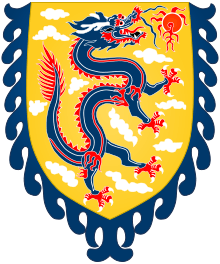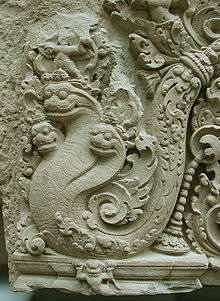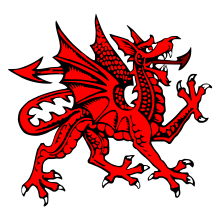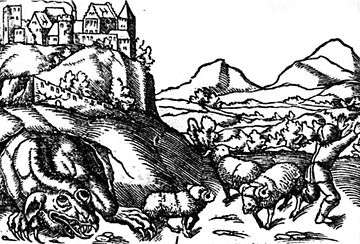List of dragons in mythology and folklore
This article is a list of dragons in mythology and folklore.
| Asian dragons | |||
| Chinese dragon | Lóng (or Loong. Lung2 in Wade-Giles romanization.) |
The Chinese dragon, is a creature in Chinese mythology that also appears in other Asian cultures, and is sometimes called the Oriental (or Eastern) dragon. Depicted as a long, snake-like creature with four claws (or five for the imperial dragon), it has long been a potent symbol of auspicious power in Chinese folklore and art. This type of dragon, however, is sometimes depicted as a creature constructed of many animal parts. It might have the fins of some fish, or the horns of a stag. | |
| Indian dragons | Nāga | A serpentine dragon common to all cultures influenced by Hinduism. They are often hooded like a cobra and may have several heads depending on their rank. They usually have no arms or legs but those with limbs resemble the Chinese dragon. Other dragons are the Vrtra the serpent dragon who is defeated by Indra the thunder god and king of heaven, and the other evil serpent in Vedic lore, Ahi (cognate with the Zoroastrian Azi Dahaka). Another dragon who appears in the Indian mythology is- the Kaliya nag, which was defeated by lord Krishna. It is said that Krishna did not kill the snake and left it. The Kaliya Nag is said to have more than 1000 fangs. All the above references are more inclined towards larger snakes, not dragons. | |
| Indonesian/Malay dragon | Naga or Nogo | Derived from the Indian nāga, belief in the Indo-Malay dragon spread throughout Maritime Southeast Asia with Hinduism. The word naga is still the common Malay/Indonesian term for dragon.[1] Like its Indian counterpart, the naga is considered divine in nature, benevolent, and often associated with sacred mountains, forests, or certain parts of the sea. | |
| Japanese dragon | Ryū  |
Similar to Chinese dragons, with three claws instead of four. They are usually benevolent, associated with water, and may grant wishes. | |
| Khmer Dragon | Neak  |
The Khmer dragon, or neak is derived from the Indian nāga. Like its Indian counterpart, the neak is often depicted with cobra like characteristics such as a hood. The number of heads can be as high as nine, the higher the number the higher the rank. Odd-headed dragons are symbolic of male energy while even headed dragons symbolize female energy. Traditionally, a neak is distinguished from the often serpentine Makar and Tao, the former possessing crocodilian traits and the latter possessing feline traits. A dragon princess is the heroine of the creation myth of Cambodia. | |
| Korean dragon | Yong (Mireu) | A sky dragon, essentially the same as the Chinese lóng. Like the lóng, yong and the other Korean dragons are associated with water and weather. In pure Korean, it is also known as 'mireu'. | |
| Imoogi | A hornless ocean dragon, sometimes equated with a sea serpent. Imoogi literally means, "Great Lizard". The legend of the Imoogi says that the sun god gave the Imoogi their power through a human girl, which would be transformed into the Imoogi on her 17th birthday. Legend also said that a dragon-shaped mark would be found on the shoulder of the girl, revealing that she was the Imoogi in human form. | ||
| Gyo | A mountain dragon. In fact, the Chinese character for this word is also used for the imoogi. | ||
| Philippine Dragon | Bakunawa | The Bakunawa appears as a gigantic serpent that lives in the sea. Ancient natives believed that the Bakunawa caused the moon or the sun to disappear during an eclipse. It is said that during certain times of the year, the Bakunawa arises from the ocean and proceeds to swallow the moon whole. To keep the Bakunawa from completely eating the moon, the natives would go out of their houses with pots and pans in hand and make a noise barrage in order to scare the Bakunawa into spitting out the moon back into the sky. Some say that the Bakunawa is known to kill people by imagining their death and remote in eye contact. | |
| Vietnamese dragon | Rồng or Long (Ly dynasty, Daiviet X) |
These dragons' bodies curve lithely, in sine shape, with 12 sections, symbolising 12 months in the year. They are able to change the weather, and are responsible for crops. On the dragon's back are little, uninterrupted, regular fins. The head has a long mane, beard, prominent eyes, crest on nose, but no horns. The jaw is large and opened, with a long, thin tongue; they always keep a châu (gem/jewel) in their mouths (a symbol of humanity, nobility and knowledge). | |
| European dragons | |||
| Catalan dragon | drac | Catalan dragons are serpent-like creatures with two legs (rarely four) and, sometimes, a pair of wings. Their faces can resemble that of other animals, like lions or cattle. They have a burning breath. Their breath is also poisonous, the reason by which dracs are able to rot everything with their stench. A víbria is a female dragon. | |
| French dragons | Dragon  |
Authors tend often to present the dragon legends as symbol of Christianity's victory over paganism, represented by a harmful dragon. The French representation of dragons spans much of European history, and has even given its name to the dragoons, a type of cavalry. | |
| Scandinavian & Germanic dragons | Lindworm  |
Lindworms are serpent-like dragons with either two or no legs. In Nordic and Germanic heraldry, the lindworm looks the same as a wyvern. The dragon Fafnir was a lindworm. | |
| English dragons | Wyvern | Wyverns are common in medieval heraldry. Their usual blazon is statant. Wyverns are normally shown as dragons with two legs and two wings. | |
| The worm hill dragon | 700 AD the Anglo-Saxons settled and called it "Wruenele" this translates as "Wruen" worm, reptile or dragon and "ele" hill. According to local folklore the hill at Knotlow (Derbyshire) was the lair of a dragon and the terraces around it were made by the coils of its tail. Knotlow is an ancient volcanic vent and this may explain the myth. | ||
| The Bisterne Dragon | The New Forest folktale states that the dragon lived in Burley, Hampshire, and terrorised the village of Bisterne. It was finally killed in Lyndhurst, Hampshire by Sir Maurice de Berkeley and its body turned into a hill called Boltons Bench. Though the knight survived, the trauma of the battle drove him mad, and soon after he returned to the hill to die, his corpse becoming a yew tree. | ||
| The Bignor Hill dragon | There is a brief mention of a Dragon on Bignor Hill south of the village of Bignor near the famous Roman Villa, apparently "A Large dragon had its den on Bignor Hill, and marks of its folds were to be seen on the hill". Similar legends have been told of ridges around other hills, such as at Wormhill in Derbyshire. | ||
| Blue Ben | Kilve in West Somerset is said to have once been home to a dragon called Blue Ben which the devil used as a steed. The skull of a fossilised Ichthyosaur on display in the local museum is sometimes pointed out as belonging to Blue Ben. | ||
| The Lambton Worm | The legend says that it curled around Worm Hill near Fatfield in northeast England, would eat livestock and children, and was killed during the time of the Crusades by a Sir John Lambton. | ||
| Welsh dragons | Y Ddraig Goch  |
In Welsh mythology, after a long battle (which the Welsh King Vortigern witnesses) a red dragon defeats a white dragon; Merlin explains to Vortigern that the red dragon symbolizes the Welsh, and the white dragon symbolizes the Saxons – thus foretelling the ultimate defeat of the English by the Welsh. The ddraig goch appears on the Welsh ¬ | |
| Hungarian dragons | sárkány | A dragon in human form. Most of them are giants with multiple heads. Their strength is held in their heads. They become gradually weaker as they lose their heads.
In contemporary Hungarian the word sárkány is used to mean all kinds of dragons. | |
| Zomok | A giant winged snake, which is in fact a full-grown zomok. It often serves as flying mount of the garabonciás (a kind of magician). The sárkánykígyó rules over storms and bad weather. | ||
| Slavic dragons | zmey, zmiy, żmij, змей, or zmaj, or drak, or smok   Smok Wawelski from Sebastian Münster's Cosmographie Universalis, 1544 |
Similar to the conventional European dragon, but multi-headed. They breathe fire and/or leave fiery wakes as they fly. In Slavic and related tradition, dragons symbolize evil. Specific dragons are often given Turkic names (see Zilant, below), symbolizing the long-standing conflict between the Slavs and Turks. However, in Serbian and Bulgarian folklore, dragons are defenders of the crops in their home regions, fighting against a destructive demon Ala, whom they shoot with lightning.[2][3] | |
| Armenian dragon | Vishap | Related to European dragons | |
| Siberian dragon | Yilbegän | Related to European Turkic and Slavic dragons | |
| Romanian dragons | Balaur, Zburator | Balaur are very similar to the Slavic zmey: very large, with fins and multiple heads. | |
| Chuvash dragons | Vere Celen | Chuvash dragons represent the pre-Islamic mythology of the same region. | |
| Asturian and Leonese dragons | Cuélebre | In Asturias and León mythology the Cuélebres are giant winged serpents, which live in caves where they guard treasures and kidnapped xanas. They can live for centuries and, when they grow really old, they use their wings to fly. Their breath is poisonous and they often kill cattle to eat. Leonese language term Cuelebre comes from Latin colŭbra, i.e., snake. | |
| Albanian Dragons | Bolla | In the Albanian mythology Bolla (also known as Bullar in South Albania), is a type of serpentic dragon (or a demonic dragon-like creature) with a long, coiled, serpentine body, four legs and small wings in ancient Albanian folklore. This dragon sleeps throughout the whole year, only to wake on Saint George's Day, where its faceted silver eyes peer into the world. The Bolla does this until it sees a human. It devours the person, then closes its eyes and sleeps again.[4] Bolla was worshiped as the deity Boa by the ancestors of Albanians, Illyrians.[5] Bolla appears in the coat of arms of the House of Bua Shpata. | |
| Kulshedra | In its twelfth year, the bolla evolves by growing nine tongues, horns, spines and larger wings. At this time it will learn how to use its formerly hidden fire-breathing abilities, and is now called a kulshedra or kuçedra (hydra). The kuçedra causes droughts and lives off human sacrifices. Kulshedras are killed by Drangue, Albanian winged warriors with supernatural powers. Thunderstorms are conceived as battles between the drangues and the kulshedras. | ||
| Dreq | Dreq is the dragon (draco) proper. It was demonized by Christianity and now is one of the Albanian names of the devil. | ||
| Portuguese dragons | Coca | In Portuguese mythology coca is a female dragon that fights with Saint George. She loses her strength when Saint George cuts off one of her ears. | |
| Greek dragons | Drákōn – δράκων  |
Cadmus fighting the Ismenian dragon (which guarded the sacred spring of Ares) is a legendary story from the Greek lore dating to before ca. 560–550 B.C. Greek dragons commonly had a role of protecting important objects or places. For example, the Colchian dragon watched the Golden Fleece and the Nemean dragon guarded the sacred groves of Zeus.[6] The name comes from the Greek "drakeîn" meaning "to see clearly".[7] | |
| Tatar dragons | Zilant  |
Really closer to a wyvern or cockatrice, the Zilant is the symbol of Kazan. Zilant itself is a Russian rendering of Tatar yılan, i.e., snake. | |
| Turkish dragons | Ejderha or Evren | The Turkish dragon secretes flames from its tail, and there is no mention in any legends of its having wings, or even legs. In fact, most Turkish (and later Islamic) sources describe dragons as gigantic snakes. | |
| Lithuanian Dragons | Slibinas | This dragon is more of a hydra with multiple heads, though sometimes it does appear with one head. | |
Other dragons in mythology and folklore
- Aido Wedo, the Rainbow Serpent of Dahomey mythology
- Apalala, a mythical river dragon who was converted to Buddhism
- Apep or Apophis the giant snake or serpent from Egyptian mythology
- Azazel is described as a dragon in the Apocalypse of Abraham
- Azhi Dahaka in Avestan mythology.
- Qinglong (or Seiryū) in Chinese mythology, one of the Four Symbols (Chinese constellation)
- Bisterne Dragon, a New Forest dragon of English folklore
- Bolla (also "Bullar"), the sleeping dragon of Albanian mythology
- Boitatá The name comes from the Old Tupi language and means "fiery serpent" (mboî tatá). Its great fiery eyes leave it almost blind by day, but by night, it can see everything. According to legend, Boi-tatá was a big serpent which survived a great deluge.
- Brnensky drak (The dragon of Brno), the dragon killed nearby Moravian city (legend)
- Con rit is a water dragon from Vietnamese mythology
- Dragon Kings, from Chinese mythology
- The Dragon of Loschy Hill, of Yorkshire folklore
- The Dragons of St. Leonard's Forest, of Sussex folklore
- Fafnir, transformed dragon (Germanic mythology)
- The Green Dragon of Mordiford, of Herefordshire folklore
- Gorynych, Zmei, the most famous of Russian dragons
- The Graoully of Metz, symbol of christianization over paganism.
- Guivres from Medieval France
- Huanglong, the Yellow Dragon of the Center, in Chinese mythology
- Jörmungandr, the sea serpent or dragon in Norse mythology
- The Knucker from Lyminster in Sussex
- Kur, the first ever dragon
- Lagarfljótsormurinn, a lake monster or dragon living in the Lagarfljót, near Egilsstaðir, Iceland.
- The Hydra, also called the Lernaean Hydra, from Greek Mythology is described as a dragon-like animal
- Illuyankas from Hittite mythology
- Ikuchi, of a youkai dragon water in Japanese mythology
- Ladon from Greek mythology
- The Laidly Worm of Spindleston Heugh, of Northumbrian legend
- The Lambton Worm, of Northumbrian legend
- The Worm of Linton, of Scottish legend
- The Ljubljana dragon, the protector dragon of Ljubljana, capital of Slovenia
- The Longwitton dragon, of Northumbrian legend
- Lotan/Leviathan from Levantine mythology and Hebrew scriptures, a demonic dragon reigning the waters
- The Meister Stoor Worm of Orkney legend
- Mushussu, musrussu or sirrush, the Babylonian dragon from the Ishtar Gate
- Níðhöggr (the 'Dread Biter', also spelled Nidhogg) from Norse mythology
- Ouroboros the "tail-eater."
- Orochi, the eight-headed serpent slain by Susanoo in Japanese mythology
- Piasa Bird of Illini people, Americas
- Puff the Magic Dragon, popular folk song hero
- Python, from Greek mythology, the snake killed by Apollo
- Quetzalcoatl from Aztec mythology has a dragon-like aspect
- Ryūjin, the dragon god of the sea in Japanese mythology.
- Sárkány, dragon of Hungarian mythology
- Sea serpent, water dragon from Worldwide
- Smok Wawelski (the Wawel Dragon) from Polish mythology, was killed by a clever shoemaker's apprentice
- The Tarasque, tamed by Saint Martha
- Thevetat
- Tiamat and Abzu from Babylonian mythology are sometimes considered dragons
- Typhon from Greek mythology is often thought of as a dragon
- Vritra, a major asura in Vedic religion
- The Whitby Wyrm of Yorkshire Folklore
- Xiuhcoatl is a serpent from Aztec mythology
- Yam from Levantine mythology
- Teju Jagua from Guaraní mythology is described was a huge lizard with seven dog-like heads, entitled to a "fiery gaze", and being associated as the god of fruits, caves and (more common with the Dragons in Europe) as the protector of hidden treasures
- Zilant, by the Tataro-Bulgarian mythology lived in present-day Kazan and is represented on the city's coat of arms
- Zirnitra, dragon-god in Wendish mythology. It was later used in the Royal Danish heraldry as a representation of Wendland
- Zmey Gorynych – The dragon of the Slavic mythology. Its name is translated as "Snake son-of-mountain" (due to the fact it lives in a mountain), it has three heads, wings, and it spits fire.
- The Amaru – Dragon or (Chimera) of Inca Mythology. It had a llama's head, fox's mouth, condor wings, snake's body, fish's tail and dragon scales.
- The unnamed five-headed dragon subdued by the Buddhist goddess Benzaiten at Enoshima in Japan in A.D. 552
- The unnamed dragon (referred to by the Saxon draca and wyrm) defeated by Beowulf and Wiglaf in the Anglo-Saxon epic poem Beowulf.
- The unnamed dragon defeated by Saint George.
See also
- Dragons in Greek mythology
- European dragon
- Chinese dragon
- List of dragons in literature
- List of fictional dinosaurs
References
- ↑ "dragon." kamus.net. 2010. http://www.kamus.net/result.php?w=en-usa&q=dragon&submit=Search&e=0 (29 June 2011).
- ↑ Зечевић, Слободан (1981). Митска бића српских предања. Belgrade: "Вук Караџић" : Етнографски музеј. (A book in Serbian about mythical creatures of Serbian traditions)
- ↑ Беновска-Събкова, Милена. "Змей". Родово Наследство. Retrieved 2007-08-13. (An extract from the book Змеят в българския фолклор (The Dragon in Bulgarian Folklore), in Bulgarian)
- ↑ Lurker, Manfred (1984). The Routledge Dictionary of Gods and Goddesses, Devils and Demons, Taylor & Francis e-Library. p.35
- ↑ Evans, A.; Destani, B.D. (2006). Ancient Illyria: An Archaeological Exploration. I. B. Tauris. p. 18. ISBN 9781845111670. Retrieved 2015-06-12.
- ↑ "Dragons of Ancient Greek Mythology THEOI.COM". theoi.com. Retrieved 2015-06-12.
- ↑ "dragon Facts, information, pictures | Encyclopedia.com articles about dragon". encyclopedia.com. Retrieved 2015-06-12.
This article is issued from
Wikipedia.
The text is licensed under Creative Commons - Attribution - Sharealike.
Additional terms may apply for the media files.